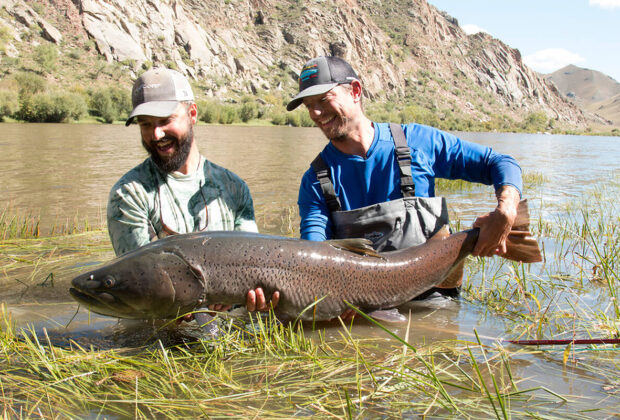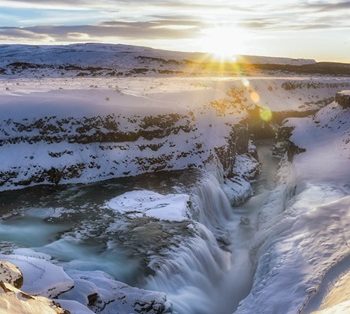Key Takeaways:
- King Salmon, also known as Chinook Salmon, are the largest species of salmon and can reach lengths of up to 58 inches and weigh over 120 pounds.
- The life cycle of King Salmon involves eggs being laid in freshwater, hatching into alevins, growing into fry, undergoing smoltification to migrate to the ocean, feeding and growing in the ocean, and returning to their birth rivers to spawn before both parents die.
- King Salmon exhibit unique behaviors such as their ability to navigate back to their birth rivers, aggression during the spawning season, and a change in feeding behavior during their migration from the ocean to freshwater.
- To have a successful fly fishing adventure for King Salmon, it is important to choose the right gear including a sturdy fly rod, strong reel, appropriate fly lines, and a strong fluorocarbon leader.
- Fly tying is essential for creating flies that imitate the natural prey of King Salmon, such as large streamers, egg imitations, and flesh flies.
- Spey casting is a casting technique that is effective for fishing large rivers and targeting King Salmon, requiring the use of longer two-handed rods.
- Top-rated destinations for King Salmon fishing include rivers in Alaska like the Kenai River, Naknek River, and Kvichak River, as well as the Columbia River in Oregon and Washington, and certain areas in the Great Lakes region.
- Remote Alaskan rivers like the Alagnak River, Kanektok River, and Togiak River offer unparalleled wilderness fishing experiences for King Salmon.
- Lesser-known spots in the lower 48 states for King Salmon fishing include the Smith River and Klamath River in northern California, and the Rogue River in Oregon and Skagit River in Washington.
- To preserve King Salmon populations, anglers should practice sustainable catch and release, respect fishing regulations and seasonal closures, support conservation organizations, and engage in citizen science initiatives.
- Engaging in citizen science projects allows anglers to contribute valuable data to ongoing research efforts focused on King Salmon, helping to protect and conserve their populations.
Facts and Fun Trivia About King Salmon
King Salmon Fly Fishing is an exhilarating experience that brings anglers the thrill of the chase and the satisfaction of conquering one of the mightiest fish in the world. Before embarking on this adventure, it's important to understand some facts and trivia about King Salmon. Let's dive into the world of this majestic species.
The Mighty King Salmon: An Introduction
King Salmon, also known as Chinook Salmon, are the largest species of salmon and highly sought after by anglers. They are known for their exceptional size, remarkable strength, and impressive fighting skills. King Salmon can reach lengths of up to 58 inches and weigh over 120 pounds in some cases.
These magnificent fish have a distinctive appearance, with a silvery body and dark blue-green back. They have black spots on their upper body, a black mouth, and gums. King Salmon also have a deeply forked tail, which contributes to their exceptional swimming speed and agility.
The Life Cycle of the King Salmon
Understanding the life cycle of King Salmon is crucial for successful fly fishing. These fish have a unique journey that takes them from freshwater to the open ocean and back to their spawning grounds.
It all begins when the eggs are laid by the female King Salmon in freshwater rivers and streams. The eggs develop and hatch into alevins, which stay in the gravel beds and feed on their yolk sacs. As they grow, they transform into fry and start feeding on insects and other small aquatic organisms.
After spending a few months in freshwater, the young King Salmon undergo a physiological change called smoltification. This prepares them for their migration to the ocean. Once in the ocean, they spend several years feeding and growing, taking advantage of the abundance of food resources.
When it's time to spawn, adult King Salmon return to the same rivers where they were born. They undergo physical changes, developing vibrant colors and a hooked jaw known as a "kype." They battle against the strong currents, leap up waterfalls, and make their way to the upper reaches of the river to find suitable spawning grounds. After the female lays her eggs and the male fertilizes them, both parents die, completing the cycle.
The Enigmatic Behaviors of King Salmon
King Salmon exhibit fascinating behaviors that make them an intriguing species to study and fish for. One notable behavior is their ability to navigate long distances back to their spawning grounds with remarkable precision. No matter how far they venture into the vast ocean, they can find their way back to the exact river where they were born.
Another interesting behavior is the aggression displayed by male King Salmon during the spawning season. As they compete for mates, they become territorial and engage in fierce battles to establish dominance. This behavior makes them susceptible to fly fishing techniques that imitate smaller fish or eggs, triggering their instinct to protect their territory.
King Salmon also have a unique feeding behavior. While in the ocean, they primarily feed on small fish, such as herring, smelt, and anchovies. However, when they enter freshwater to spawn, they stop feeding and rely on their fat reserves to sustain them throughout the spawning process.
Tactics and Techniques for a Successful Fly Fishing Adventure
Fly fishing for King Salmon requires a combination of skill, knowledge, and the right techniques. In this section, we will explore the tactics and techniques you need to master in order to have a successful fishing adventure.
Choosing the Right Gear for King Salmon Fishing
When it comes to gear, choosing the right equipment is crucial for battling with these powerful fish. A sturdy fly rod with a weight rating of at least 8-9 is recommended to handle the heavy lines and large flies necessary for King Salmon fishing. The reel should have a strong drag system to withstand their powerful runs.
For fly lines, a weight-forward floating line is commonly used for King Salmon fishing. This allows for accurate casting and easy line management. However, depending on the fishing conditions and water depth, sinking lines or sink-tip lines may also be necessary.
Leader and tippet selection is important to ensure a stealthy presentation. A strong fluorocarbon leader with a breaking strength of at least 20 pounds is recommended. Adding a section of heavy tippet material also helps to prevent breakoffs when battling these powerful fish.
The Art of Fly Tying: Creating Irresistible Salmon Flies
Fly tying is an essential skill for any fly angler, and tying your own salmon flies adds an extra layer of satisfaction and customization to your fishing experience. When tying flies for King Salmon, it's important to create patterns that imitate the natural prey of these fish.
Popular fly patterns for King Salmon include large, brightly colored streamers, egg imitations, and flesh flies. The key is to use materials that create movement and attract attention, such as marabou, rabbit strips, and flash materials. Experimentation and creativity are encouraged when tying flies, as different patterns and colors can be effective in different fishing conditions.
Mastering Spey Casting: A Key to Landing King Salmon
Spey casting is a casting technique that is particularly effective for fishing large rivers and targeting King Salmon. This casting style utilizes longer two-handed rods and allows for efficient and powerful casts, covering a wide range of water with minimal effort.
Mastering spey casting takes practice, but with time and dedication, it can greatly improve your chances of success when fishing for King Salmon. It's important to learn the correct hand placement, timing, and use of body rotation to generate power and achieve maximum distance and accuracy.
Working with a knowledgeable instructor or attending spey casting clinics can speed up the learning process and help you become a proficient spey caster.
Best Locations for King Salmon Fishing
When it comes to finding the best locations for King Salmon fishing, there are several top-rated destinations that offer incredible opportunities to pursue these magnificent fish. Whether you prefer remote Alaskan rivers or lesser-known spots in the lower 48 states, there are options for anglers of all preferences.
Top-Rated King Salmon Fishing Destinations
Alaska is undoubtedly the top-rated destination for King Salmon fishing. The state is home to countless rivers and streams that provide prime habitat for these fish. The Kenai River, the Naknek River in Bristol Bay, and the Kvichak River are just a few examples of renowned fisheries that attract anglers from around the world.
Other top-rated destinations include the Columbia River in Oregon and Washington, which sees a significant run of King Salmon each year, and the Great Lakes region, where they have been introduced and thrive in certain areas.
Exploring the Remote Alaskan Rivers for King Salmon
For those seeking a true wilderness adventure, exploring remote Alaskan rivers is an unparalleled experience. Remote rivers provide unparalleled solitude and the opportunity to fish in untouched environments.
Rivers such as the Alagnak River, the Kanektok River, and the Togiak River offer remarkable scenery, abundant wildlife, and exceptional King Salmon fishing. These remote destinations often require fly-in access and the assistance of experienced guides to navigate the challenging terrain.
Lesser-Known Spots in The Lower 48 for King Salmon
While Alaska may be the top destination for King Salmon, there are also lesser-known spots in the lower 48 states that offer exciting fishing opportunities. In northern California, the Smith River and the Klamath River are known for their runs of large King Salmon.
The Rogue River in Oregon and the Skagit River in Washington are also lesser-known gems that provide excellent fishing for these powerful fish.
Conservation and Preservation of King Salmon Populations
As responsible anglers, it is important to prioritize the conservation and preservation of King Salmon populations to ensure their long-term survival. Here are some key practices and initiatives aimed at protecting these magnificent fish.
Sustainable Practices: Ensuring the Future of King Salmon
Adopting sustainable fishing practices is crucial for the future of King Salmon populations. This includes practicing catch and release whenever possible, especially for wild and endangered stocks. Handling the fish carefully, minimizing stress, and quickly releasing them back into the water can significantly increase their chances of survival.
Respecting fishing regulations and seasonal closures is also essential to protect spawning runs and allow for successful reproduction. It's important to stay informed about local fishing regulations and be mindful of conservation efforts that aim to preserve King Salmon populations.
The Threats to King Salmon Populations and How to Combat Them
King Salmon populations face various threats that can impact their numbers and overall health. Habitat destruction, pollution, overfishing, and climate change are some of the major challenges these fish face.
To combat these threats, it is important to support conservation organizations and initiatives that work towards protecting and restoring salmon habitats. Volunteering for river clean-ups, participating in habitat restoration projects, and advocating for responsible fishing practices are effective ways to contribute to the conservation of King Salmon populations.
Engaging in Citizen Science: Contributing to King Salmon Research
Engaging in citizen science projects allows anglers to contribute valuable data and information to ongoing research efforts focused on King Salmon. Participating in programs such as fish tagging, DNA sampling, and scale collection can provide scientists with valuable insights into migration patterns, population dynamics, and genetic diversity.
By actively participating in these initiatives, anglers can play an active role in the conservation and preservation of King Salmon populations, helping to ensure their survival for future generations of anglers to enjoy.
In conclusion, embarking on a fly fishing adventure for King Salmon is an experience that combines the thrill of the chase, the beauty of nature, and the satisfaction of conquering a mighty fish. By understanding the facts, mastering the techniques, and prioritizing conservation efforts, anglers can have a meaningful and unforgettable encounter with the majestic King Salmon.
FAQ
Question: How big can King Salmon grow?
Answer: King Salmon, also known as Chinook Salmon, can reach lengths of up to 58 inches and weigh over 120 pounds.
Question: What is the life cycle of King Salmon?
Answer: The life cycle of King Salmon involves laying eggs in freshwater, hatching into alevins, growing into fry, migrating to the ocean, feeding and growing in the ocean, and returning to their birth rivers to spawn before both parents die.
Question: What unique behaviors do King Salmon exhibit?
Answer: King Salmon have the ability to navigate back to their birth rivers, display aggression during the spawning season, and change their feeding behavior during migration from the ocean to freshwater.
Question: What gear is necessary for a successful fly fishing adventure for King Salmon?
Answer: To have a successful fly fishing adventure for King Salmon, it is important to choose the right gear including a sturdy fly rod, strong reel, appropriate fly lines, and a strong fluorocarbon leader.
Question: What types of flies should be used to imitate the natural prey of King Salmon?
Answer: Flies that imitate the natural prey of King Salmon include large streamers, egg imitations, and flesh flies.
Question: What is spey casting and why is it effective for King Salmon fishing?
Answer: Spey casting is a casting technique that is effective for fishing large rivers and targeting King Salmon. It requires the use of longer two-handed rods and allows for efficient and powerful casts, covering a wide range of water with minimal effort.
Question: What are some top-rated destinations for King Salmon fishing?
Answer: Top-rated destinations for King Salmon fishing include rivers in Alaska such as the Kenai River, Naknek River, and Kvichak River. The Columbia River in Oregon and Washington, as well as certain areas in the Great Lakes region, are also popular destinations.
Question: How can anglers contribute to the conservation of King Salmon populations?
Answer: Anglers can contribute to the conservation of King Salmon populations by practicing sustainable catch and release, respecting fishing regulations and seasonal closures, supporting conservation organizations, and engaging in citizen science initiatives to provide valuable data for ongoing research efforts.
Useful Resources
- https://www.salmonfishing.com/ - Salmon Fishing: A comprehensive website with information on different species of salmon, including King Salmon, and tips for successful fishing.
- https://www.flyfisherman.com/ - Fly Fisherman Magazine: A leading publication for fly fishing enthusiasts, featuring articles, tutorials, and destination guides.
- https://www.alaska.gov/ - State of Alaska: Official website of the State of Alaska, providing information on fishing regulations, licenses, and top-rated fishing destinations in Alaska.
- https://www.usgs.gov/ - U.S. Geological Survey: A scientific agency that conducts research on various aspects of salmon populations and their habitats.
- https://www.troutunlimited.org/ - Trout Unlimited: A nonprofit organization dedicated to conserving coldwater fisheries, including the preservation of salmon populations.
- https://www.fisheries.noaa.gov/ - National Oceanic and Atmospheric Administration (NOAA) Fisheries: The federal agency responsible for the stewardship of the nation's fisheries, including salmon conservation efforts.
- https://www.usfs.gov/ - U.S. Forest Service: A government agency that manages national forests and grasslands, providing habitat for salmon and protecting their spawning grounds.
- https://www.fedflyfishers.org/ - Federation of Fly Fishers: An organization that promotes the sport of fly fishing and offers educational resources, workshops, and conservation programs.























